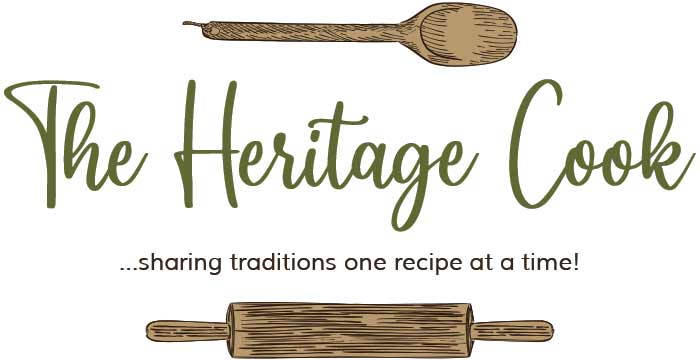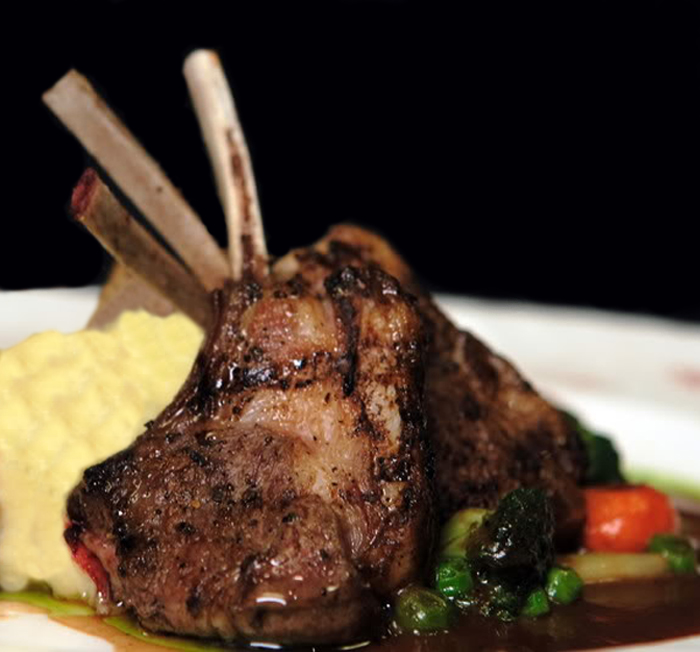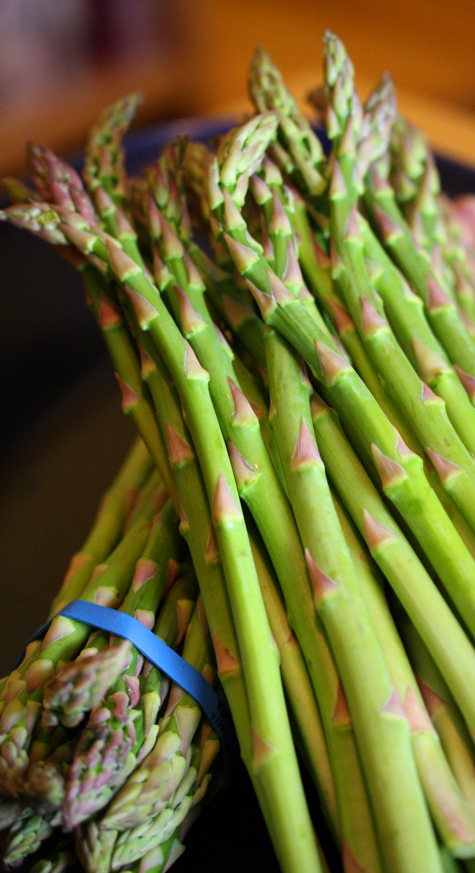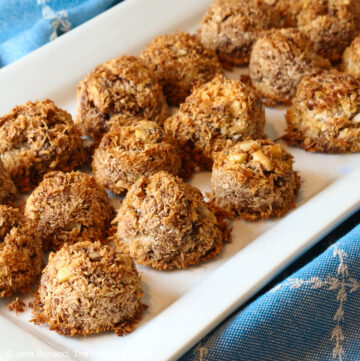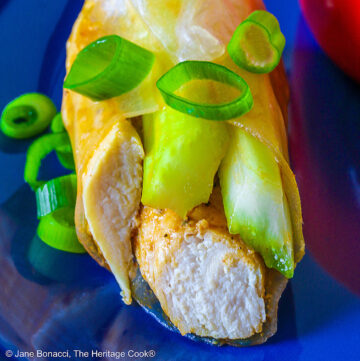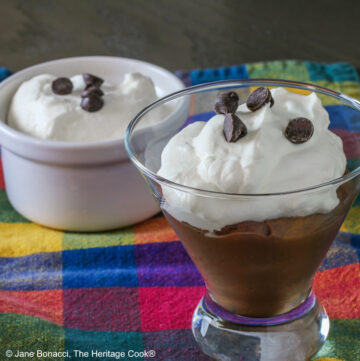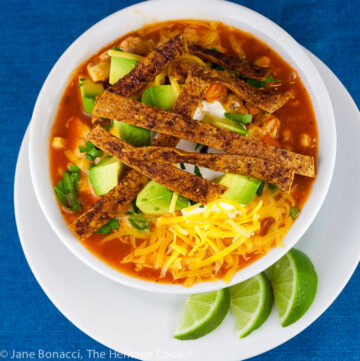Today’s Recipes: Grilled Lamb Chops with Lemon, Cucumber and Tomato Tzatziki, Lemon-Garlic Roasted Potatoes, and Grilled Asparagus with Lemon-Parmesan Ricotta Sauce.
On a beautiful, warm summer evening a friend threw a barbecue for our whole crowd. He was an avid foodie with a lot of skill in the kitchen so we knew the party was going to be something to remember. The patio was lit with strings of lights woven through the trees and the tables were set for a multi-course dinner. Glassware sparkled in the light of the candles strewn down the tables. A huge piece of meat was cooking on the grill and the aromas coming from it had everyone drooling, we couldn’t wait for dinner.
Course after course came out of the kitchen and the wine flowed. There were peals of laughter, the clinking of glasses, and many toasts made. When the entree was served it was quite dark and we couldn’t really see what we were eating. There were a lot of jokes about how it could have been anything and we wouldn’t know any better. One bite and I knew it was the best thing I had ever eaten, but no one could identify for sure what it was. There were lots of guesses and we finally had to ask my friend what he had prepared. When he told us it was leg of lamb, I just about fell off my chair! There was absolutely no way that this delicately flavored, tender, juicy meat could be lamb. That was the day I learned that not all lamb is created equal.
Lamb is one of those foods that people are either in love with or not and I’m on the “not” side of the fence. I don’t like the muskiness of lamb and no amount of mint jelly could drown it out when I was growing up. It was one of my mother’s favorite meals and we had to suffer through it at least once a year. Because of ignorance and habit, my mother always cooked our meats well done, which turned everything into shoe leather. As it turns out, the kind of lamb you purchase and how you cook makes all the difference.
The general rule with lamb (and also beef) is that the lighter the color, the younger the meat. Baby or Spring lamb is pale pink and very mild in flavor. The darker the meat, the stronger the flavor. The cut of the meat also affects the flavor. There are musk or acid glands located in the large fat pockets near the joints of the leg and shoulder. If these aren’t removed very carefully they can give the entire piece of meat a stronger flavor. For the mildest flavor, choose a rack of lamb or loin chops. These are located the furthest from the joints and you won’t be disappointed. If you want to use the leg, have your butcher bone, de-musk, butterfly and trim off the extra fat.
Like most proteins, lamb is optimally cooked just to medium-rare or medium at the most. This keeps the meat tender and juicy. When I was growing up, all of our meat was cooked well done because we didn’t know any better. When I became anemic, my doctors told us that I had to eat beef as rare as I could stand it to boost my iron. It took us awhile to adjust to it, but now I can’t imagine eating meat cooked any other way. It loses so much of its flavor when it is overcooked.
Sheep were first brought to North America in 1519 by Spanish soldiers under the command of Cortez and were an important source of food and wool. The inclusion of sheep in cattle herds in the 1800s created a battle that raged for decades between the cattlemen and sheepherders. The two had to compete for land and grass to graze their herds on and the contention between them often led to bloodshed. The cattlemen persevered and to this day beef is much more popular in America than lamb.
Today’s lamb recipe comes from Michael Symon, a James Beard award-winning chef, restaurateur, and author. Proud of his Greek heritage, his specialties are Mediterranean cuisines. You can see these influences in his choices of herbs and spices for the lamb, with lemon, garlic, mint, and oregano. Grilling the chops adds a smokiness that blends well with the sweetness of the lamb and spiciness of the seasonings. The recipe calls for marinating the chops overnight in the refrigerator, so plan accordingly.
A traditional Greek accompaniment to roasted meats is Tzatziki, a sauce made from yogurt and cucumbers. It is cool and refreshing, perfect to highlight the flavors of the lamb. Some form of it is served in most Mediterranean countries. Today’s recipe includes chopped tomatoes which add a wonderful bright red to the white sauce.
Chef Symon accompanies his lamb with lemon and garlic roasted potatoes that are out of this world. Fingerling potatoes are small, young, elongated potatoes that are extremely tender when roasted. They are definitely worth the extra expense for a special meal. You can substitute Yukon Golds, red bliss, or Russets if you prefer.
And to continue with the lemon and Mediterranean flavors, I wanted to share my recipe for grilled asparagus with a lemon, Parmesan, and Ricotta sauce. Smoky and seasoned lightly with salt and pepper, the asparagus is wonderful served alongside the lamb and potatoes. I would be happy to eat the entire bunch by myself! Make sure you don’t overcook the asparagus. You want it still crisp, almost crunchy. It will continue to cook after you take it off the heat, so remove it earlier than you probably think you should and it will be perfect when you serve it. If it is too crunchy for your taste you can always pop it in the microwave for 30 seconds to finish.
This combination of dishes is a great way to introduce your family to Mediterranean flavors. Add some Greek music and Ouzo and everyone is guaranteed to have a wonderful time. Break a few plates, dance around the room and yell Opa!!!
Jane’s Tips and Hints:
Always make sure you wash every piece or fruit and all vegetables well before slicing into them. I like to use a vegetable and fruit wash such as Fit. It removes pesticides, waxes, and other contaminants better than water alone. If you do not wash them first, any contaminants on the outside will be carried to the inside by the knife blade when you cut into them.
Kitchen Skill: How to Get the Most Juice from Lemons
When you are juicing any citrus fruits, there are a few tricks for getting the most out of each piece. Start by microwaving the fruit for 5 seconds. Then roll them back and forth on the counter. This helps break down the cells and membranes, releasing more juice. And finally, using a wooden reamer creates extra friction forcing more juice from the fruits. Always work over a sieve to catch the seeds and if you are using the zest, make sure you only remove the colored part of the rind. The white pith is very bitter.
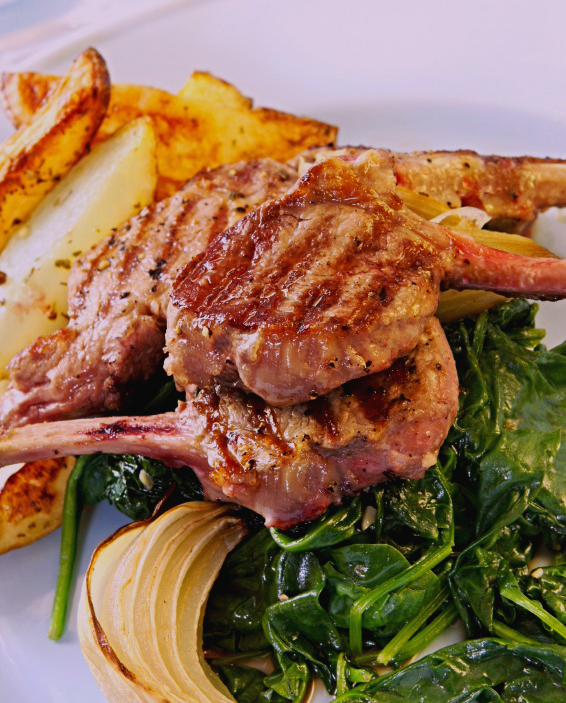

- 3 large shallots, minced
- 6 tbsp chopped fresh mint
- 6 tbsp chopped fresh oregano
- 6 large garlic cloves, minced
- 1 tbsp sugar
- 24 lamb rib chops (from 3 racks of lamb, 1-1/4- to 1-1/2 lb each, cut between bones into individual chops or have your butcher cut double chops - each chop has 2 ribs)
- 6 tbsp extra-virgin olive oil
- 3 tbsp fresh lemon juice (from 1 to 2 lemons)
- 1 tbsp finely grated lemon peel
- Fresh oregano sprigs (for garnish)
- Mix minced shallots, chopped mint, chopped oregano, minced garlic, sugar, and 1 tbsp salt in small bowl. Press 1 rounded tsp shallot-herb mixture onto eye (round meaty portion) of each lamb chop. Turn chops over onto large rimmed baking sheet. Press remaining shallot- herb mixture onto eye of each chop. Cover lamb chops with plastic wrap and refrigerate overnight.
- Whisk olive oil, lemon juice, and lemon peel in small bowl until slightly thickened and well blended. Season lightly with salt and generously with freshly ground black pepper. Spoon oil mixture lightly over chops. Turn chops over and spoon remaining oil mixture over. Let stand at room temperature 1 hour.
- Prepare barbecue (medium-high heat). Grill lamb chops to desired doneness, about 3 minutes per side for medium-rare. Transfer lamb chops to platter. Garnish with fresh oregano sprigs and serve.
- 3 cups plain yogurt (do not use low-fat or nonfat) or Greek yogurt
- 1 English hothouse cucumber (about 16 oz), peeled, halved lengthwise, with the seeds scraped out
- 3 tbsp finely chopped fresh dill
- 1 large garlic clove, minced
- 1 large tomato, quartered, seeded, thinly sliced
- Place strainer over large bowl. Line strainer with 3 layers of cheesecloth. Spoon yogurt into lined strainer; let stand at room temperature 3 hours (liquid will drain out and yogurt will thicken). Transfer drained yogurt to medium bowl; discard liquid. If you are using Greek yogurt this step has already been done for you, saving you the time and effort.
- Meanwhile, coarsely grate cucumber. Place in another strainer; let stand at room temperature until most of liquid drains out, about 3 hours. Discard liquid. Squeeze excess moisture from cucumber.
- Mix cucumber, dill and garlic into yogurt. Can be made 1 day ahead to this point. Cover and refrigerate.
- When ready to serve, mix tomato into yogurt. Season to taste with salt and pepper and serve with grilled lamb chops.
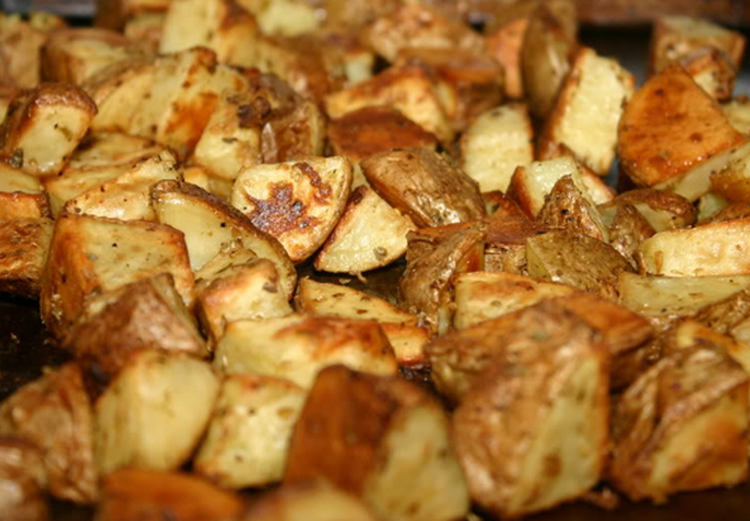

- Nonstick vegetable oil spray
- 4 lb unpeeled fingerling potatoes in assorted colors (such as red, white, and purple), rinsed, halved lengthwise or cubed
- 1/2 cup olive oil
- 1 cup extra-virgin olive oil
- 1/2 cup freshly squeezed lemon juice
- 6 tbsp chopped fresh dill
- 4 tsp finely grated lemon peel
- 24 garlic cloves, sliced
- Position one rack in top third and one rack in bottom third of oven and preheat to 375°F. Spray 2 large rimmed baking sheets with nonstick spray.
- Toss potatoes with 1/2 cup olive oil in large bowl. Sprinkle generously with salt and freshly ground black pepper. Spread potatoes in single layer on baking sheets, dividing equally. Roast 30 minutes.
- Meanwhile, whisk extra virgin olive oil, lemon juice, dill, and lemon peel in small bowl to blend for dressing.
- Toss garlic and 2 tbsp dressing in another small bowl. Divide garlic mixture between baking sheets with potatoes and toss; reverse baking sheets and continue to roast until potatoes are tender and brown around edges, about 15 minutes longer.
- Toss roasted potatoes in large bowl with enough of remaining dressing to coat and serve.
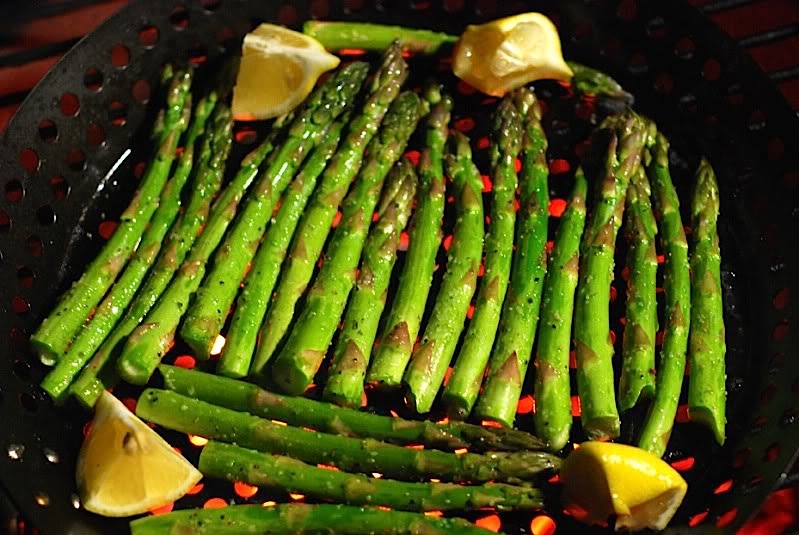

- 1 cup whole ricotta cheese, drained (do not use non-fat version)
- Juice of 1 lemon
- 1/4 cup finely grated Parmesan cheese
- 1-1/2 tsp minced fresh oregano leaves or 3/4 tsp dried oregano
- Coarse salt and freshly ground pepper to taste
- 2 lb asparagus spears, medium to thick
- Good quality olive oil
- Lemon slices or wedges, for garnish
- In a small bowl, gently stir together the drained ricotta, lemon juice, Parmesan, oregano, salt, and pepper. Set aside to allow flavors to blend for 30 minutes. Taste and adjust seasonings.
- Ignite charcoal in barbecue. Set coals on one side for both searing and indirect heating. When hot, brush grill with olive oil. If using a gas grill, heat one side only.
- Trim woody ends from the asparagus and discard. Toss spears generously with olive oil and sprinkle with salt and pepper. Using tongs, carefully place over indirect heat side of hot grill, thick ends toward heat source. Cook for 2 to 3 minutes, and then roll them to expose the other side to the heat. Cook another minute or two or until crisp-tender. Length of cooking time will vary depending on the thickness of asparagus and heat of grill.
- When done, remove from the heat and transfer to a warmed serving platter. Spread ricotta mixture liberally across center of spears. Garnish with lemon and serve immediately. Pass any additional ricotta separately.
Thank You!
